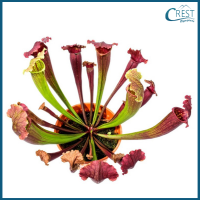1. During a nature walk, Miles came across a wet marshy area. Which of the following plants is he likely to find in this habitat?
a) Pine tree
b) Cactus
c) Water lily
d) Buffalo grass
Answer: c) Water lilies are aquatic plants that thrive in water bodies such as ponds, lakes, and marshes. They have adapted to grow in wet environments with their floating leaves and long stems.
2. To understand the adaptation of desert plants, a student conducted an experiment. She planted two types of plants, one with thick, fleshy stems and leaves and the other with regular leaves, in a pot. The pots were placed under direct sunlight without water for a week. What is the expected outcome of the experiment?
a) Both types of plants will thrive.
b) Both types of plants will wilt and die.
c) The plant with regular leaves will survive.
d) The plant with thick, fleshy stems and leaves will survive.
Answer: d) Plants with thick, fleshy stems and leaves have adaptations that allow them to store water more effectively. This adaptation helps them withstand long periods without water.
3. Which of the following adaptations allows the plant shown in the picture to capture insects?

a) Spiky leaves for protection
b) A deep pitcher-shaped structure filled with digestive enzymes
c) Sweet fragrance to attract insects
d) Specialised leaves that snap shut when an insect touches them
Answer: b) The pitcher-shaped structure acts as a trap for insects. The plant secretes digestive enzymes into the pitcher, breaking down the trapped insects and absorbing the nutrients for its own survival.
4. What would happen if coniferous trees did not have needle-like leaves?
a) The trees would not be able to withstand snowy conditions.
b) The trees would not be able to photosynthesise effectively.
c) The trees would be more prone to diseases and insect attacks.
d) The trees would lose excessive amounts of water through evaporation.
Answer: a) The needle-like shape and structure of the coniferous trees allow snow to slide off easily, preventing the accumulation of heavy snow on the branches.
5. Suppose you come across a plant with long stems, hollow and light in weight and firm, flat and broad leaves. Which type of habitat do you think this plant is adapted to?
a) Mountains
b) Deserts
c) Grasslands
d) Aquatic environment
Answer: d) Based on the description provided, the plant is likely adapted to an aquatic environment. The long stems and hollow nature of the plant allow it to float or be submerged in water. The firm, flat, and broad leaves are well-suited for capturing sunlight in a water-rich environment.


